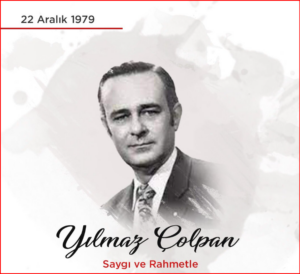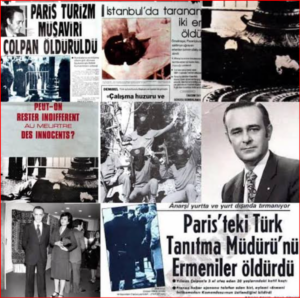
In solemn commemoration, we pay tribute to the memory of Yılmaz Çolpan, the esteemed Tourism and Information Counsellor of the Turkish Embassy in Paris, who tragically fell victim to a reprehensible act of violence perpetrated by the terrorist organization JCAG on the fateful day of December 22, 1979.
Forty-four years later, on December 22, 2023, the Turkish Foreign Ministry conveyed a profound tribute to Çolpan, honoring his memory as a martyr. Beyond this commemoration, they took the opportunity to underscore their deep respect for his legacy, emphasizing the irreplaceable loss experienced by the Turkish state and the bereaved Çolpan family.

Yılmaz Çolpan, who held the esteemed position of Tourism and Information Counsellor at the Turkish Embassy in Paris, met an untimely demise because of a reprehensible act of violence orchestrated by the Justice Commandos of the Armenian Genocide (JCAG), an Armenian terrorist organization just outside the Fouquet restaurant in close proximity to Champs-Élysées.
The assassination of Çolpan forms a solemn chapter within a disquieting narrative of violence enacted by Armenian terrorist groups, most notably the JCAG and the Armenian Secret Army for the Liberation of Armenia (ASALA), both of which were established in 1975. Regrettably, these groups have been responsible for the tragic loss of 31 Turkish diplomats and their family members since the tumultuous 1970s.
Engaging in acts of terrorism to further terrorism and murder against Turks, terrorist Armenians targeted the diplomatic cadre trained by Türkiye during the period of 1973-1994. In addition to diplomats, their family members, assistants, and commercial representatives were also targets of assassinations, resulting in numerous traumatic incidents. Thus, Armenian terrorism targeted Turks as part of a racist, terrorist, and psychological warfare both domestically and internationally, utilizing terrorism for propaganda in hopes to instill fear and intimidation. Today, there are numerous terrorist organizations in the world aimed at dividing, fragmenting, and destroying the Turkish nation and the Republic of Turkey. Among these terrorist groups, those of Armenian origin hold a significant place.
A short history of Armenian terrorism
From the 1878 Berlin Treaty, which marked the turning point in Turkish-Armenian relations, to the present day, four major Armenian terror campaigns have occurred. The first of these campaigns occurred in the 1860s and involved massacres, assassinations, arson, and terrorism with the intention to draw the attention of Western powers. When Armenian nationalists realized that their demands for autonomy and independence were not being considered by imperialist states, they attempted to draw attention through a new method of terrorism. In the 1860s, the first Armenian societies were established for social purposes. After 1878, influenced by Armenians living outside Ottoman territory, they turned to terrorism. There were several terrorist attacks in Istanbul, Trabzon, Van, and Erzurum, aiming to achieve their goals through social trauma (for more on the subject and the racism, defamation, and attacks against Turks, please consult: McCarthy, Justin. The Turk in America: The Creation of an Enduring Prejudice. University of Utah Press, 2011., https://doi.org/10.1353/book41476).
At the general assembly held by the Tashnaks in Tbilisi in 1892, the first ‘Fedai Movement’ was initiated and organized. This terrorist organization continued its activities by forming squads and infiltrated the borders of the Ottoman Empire to carry out massacres (for more on the subject, please consult: McCarthy, Justin, and Carolyn McCarthy. Turks and Armenians: A Manual on the Armenian Question. Committee on Education, Assembly of Turkish American Associations, 1989). The NEMESIS group is also a part of this terrorist organization. This group, at the ‘9th Tashnak World Congress’ held in Erzurum in 1919, decided to track down and assassinate former Ottoman officials in exile, organizing this as a ‘Revenge Operation’. The Ramgavars, like the Hunchak Party, with Marxist views, were organized under the name ‘Armenian Democratic Liberal Party.’ Originated in Massachusetts, this party was established in Istanbul in 1908 and aimed to forge tight connections among scattered organizations under the banner of international Armenian and to pursue more effective organizations for the salvation of Armenian.
During the First World War, the Armenians, who were Ottoman citizens and joined the army, switched sides at every chance, joined the invading enemy militaries (French or Russian), and committed treason against the Ottoman army by poisoning food and water supplies, revealing Ottoman military secrets, and committed acts of treason (please consult: Sonyel, Salahi Ramadan. The Ottoman Armenians: victims of great power diplomacy. London: K. Rustem & Brother, 1987). On December 6, 1918, Greek and Armenian churches established the Greek-Armenian Union Committee in Anatolia to act against Turks. When we look at the Armenian movements in Eastern Anatolia during the years of the War of Independence, with the start of the Greek occupation on the Western Front, they fought against Turks wearing Greek uniforms. This is also the reason why they were sent to Greece along with the Greeks from the region.
After the Independence War was won by the Kemalists, Armenians carried out murders against former Ottoman ministers and administrators. This period ended with the assassinations of Talat, Cemal, and Sait Pashas, as well as Bahattin Şakir and Cemal Azmi Beys. The fourth series of Armenian terror and murders occurred from 1973 to 1985, targeting Turkish representatives and diplomats in Turkiye and abroad. In subsequent years, the Armenians, continuing their terrorist activities, have waged a psychological and terrorist war to ensure lies, defamation, and terrorist acts of violence against Turks all over the world. Their commencement of commemorating the year 1965 as the 50th anniversary of the capture and arrest of terrorist traitors on April 24, 1915, has also been a harbinger of a new wave of terror. It is noteworthy to note that Armenian terrorists caught on April 24th, 1915, for the massacres they committed against innocents in Van region, were later let go by the Ottoman government because of pressure of the Empire powers (for more on the subject, please consult: McCarthy, Justin, Esat Arslan, and Cemalettin Taskiran. The Armenian Rebellion at Van. Salt Lake City: University of Utah Press, 2006).
Armenian patriarchates and churches, educational institutions, and political organizations around the world have been mobilized and declared ‘April 24, 1915’, as part of a lie and defamation campaign of ‘Armenian Genocide Day’. Since 1965, this day has been commemorated by Armenians all over the world, typical lies of racist defamation and terror program against Turks have been repeated, and as in every Armenian gathering, Turks have continued to be defamed and targeted.
The recent wave of Armenian terrorism systematically started in 1973. It began with the ‘Individual Armenian Terrorism’ on January 27, 1973, in Santa Barbara, USA, when an elderly Armenian named Gurgen (Karekin) Yanikan, under the guise of wanting to present a painting, lured Turkey’s Los Angeles Consul General Mehmet Baydar and Consul Bahadir Demir to a hotel room and murdered them. This was followed by ‘Organized Armenian Terrorism’ from 1975 onwards, with Armenian attacks rapidly intensifying against Turkish officials, embassies, and institutions abroad. While these assassinations were being reported in the press, the reference to the 1915 events as a genocide led Armenians to believe they could gain more attention. Using this situation, they carried out attacks on 34 Turkish diplomats between 1973 and 1993. Additionally, attacks on Istanbul and Ankara airports, which resulted in 13 deaths and 109 injuries, were joint operations by the extreme left-leaning ASALA and JCAG.